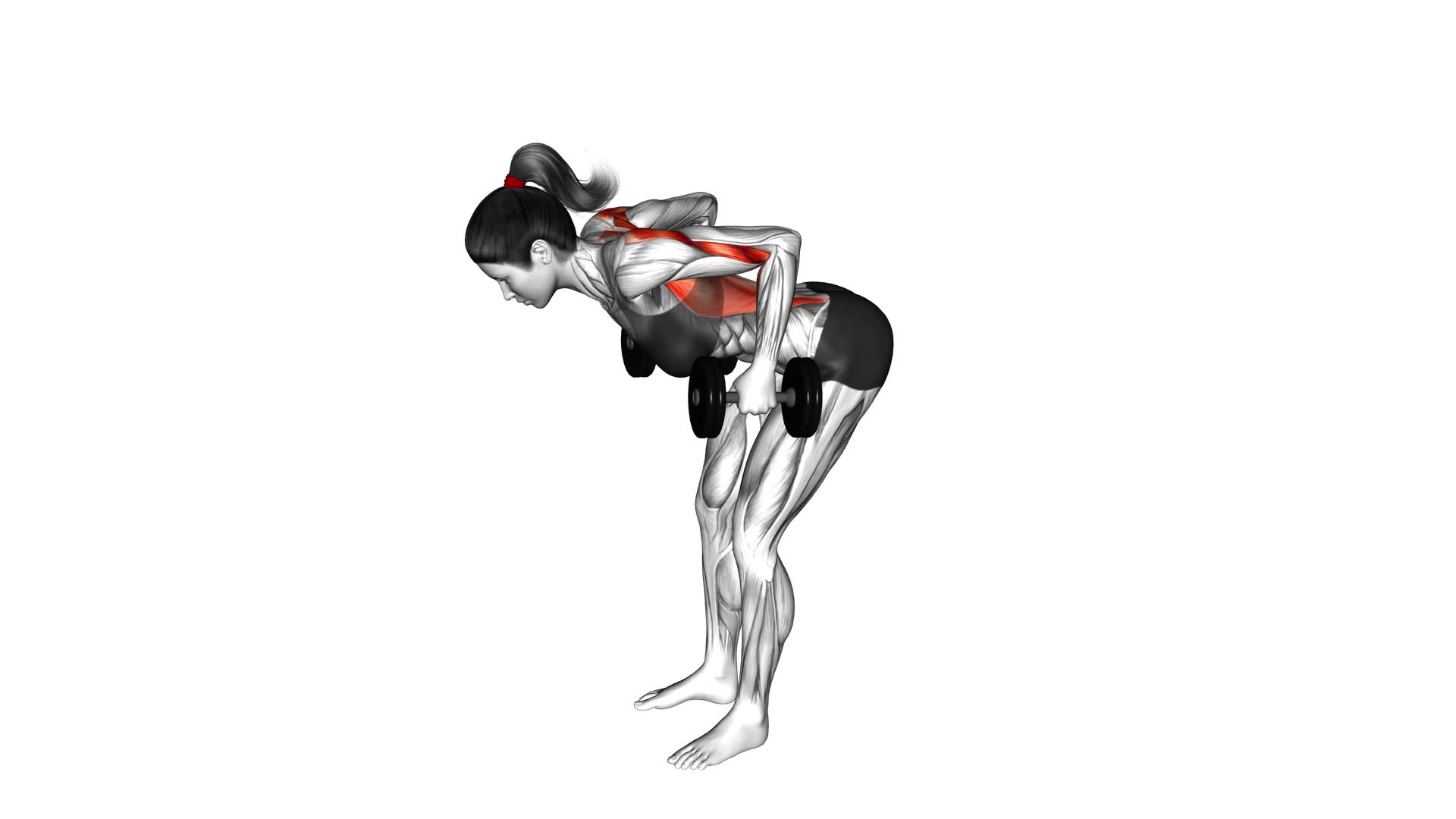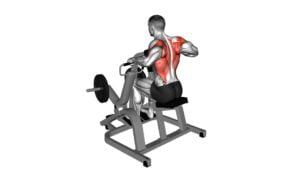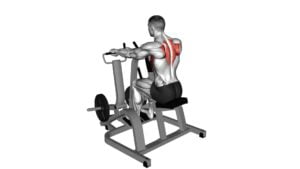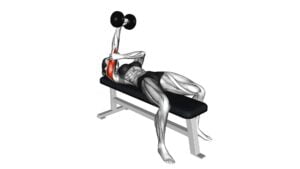Dumbbell Pronated to Neutral Grip Row (female) – Video Exercise Guide & Tips

Are you looking for a way to strengthen your back and improve your posture? Look no further than the dumbbell pronated to neutral grip row.
Watch This Exercise Video
This exercise targets your upper back muscles and helps to correct imbalances.
In this video exercise guide, we'll show you the proper form and technique, as well as provide tips for choosing the right dumbbell weight and avoiding common mistakes.
Get ready to level up your fitness routine with this effective exercise.
Key Takeaways
- Targets upper back muscles (rhomboids, trapezius, and latissimus dorsi)
- Improves posture and reduces back pain
- Engages biceps, forearms, and shoulders
- Enhances overall upper body strength
Benefits of the Dumbbell Pronated to Neutral Grip Row
You will experience several benefits when performing the Dumbbell Pronated to Neutral Grip Row.
This exercise primarily targets the muscles of your upper back, including the rhomboids, trapezius, and latissimus dorsi. By strengthening these muscles, you can improve your posture and reduce the risk of developing back pain. Additionally, the Dumbbell Pronated to Neutral Grip Row engages your biceps, forearms, and shoulders, helping to develop strength and definition in these areas.
Another benefit of this exercise is that it can enhance your overall upper body strength. As you row the dumbbells towards your body, you're required to engage multiple muscle groups simultaneously, leading to increased strength and power. This exercise can also improve your grip strength, which is essential for various activities such as lifting heavy objects or participating in sports.
Incorporating the Dumbbell Pronated to Neutral Grip Row into your workout routine can also contribute to improved muscular balance. This exercise targets the muscles on the backside of your body, which are often neglected in favor of the muscles on the front side. By strengthening your back muscles, you can correct imbalances and promote better overall muscle symmetry.
Now that you understand the benefits of the Dumbbell Pronated to Neutral Grip Row, let's move on to discussing the proper form and technique for this exercise.
Proper Form and Technique for the Exercise
When performing the Dumbbell Pronated to Neutral Grip Row, proper hand positioning is crucial for maximizing the effectiveness of the exercise. By maintaining a neutral grip, with your palms facing each other, you engage different muscles in your back and arms compared to a pronated grip.
It's important to avoid common mistakes such as using excessive weight or allowing your shoulders to hunch forward, as these can lead to poor form and potential injury.
Hand Positioning Importance
To ensure proper form and technique during the Dumbbell Pronated to Neutral Grip Row exercise, it's crucial to pay attention to the positioning of your hands. Proper hand placement is essential for maximizing the benefits of this exercise.
By maintaining a pronated to neutral grip, you engage multiple muscles in your upper body, including the back, shoulders, and biceps. This grip allows for a greater range of motion, enabling you to target different muscle groups effectively.
Additionally, the positioning of your hands helps to maintain stability and prevent injury. Placing your hands too close together or too far apart can lead to improper form and strain on your joints.
Therefore, focus on maintaining a comfortable and stable hand placement throughout the exercise to optimize your workout and minimize the risk of injury.
Avoiding Common Mistakes
Maintain a stable and controlled movement throughout the Dumbbell Pronated to Neutral Grip Row exercise to ensure proper form and technique. Avoid the following common mistakes and keep these tips in mind for improvement:
- Rounding your back: Keep your back straight and avoid rounding your shoulders to prevent strain on your spine.
- Using momentum: Focus on using your muscles to pull the dumbbells towards your body, rather than relying on momentum to complete the movement.
- Gripping too tightly: While it's important to have a firm grip on the dumbbells, avoid gripping too tightly as it can lead to unnecessary tension in your forearms.
- Not engaging your core: Remember to engage your core muscles throughout the exercise to maintain stability and prevent excessive movement.
Choosing the Right Dumbbell Weight for Your Fitness Level
When choosing the right dumbbell weight for your fitness level, it's important to start with lighter weights and gradually increase the weight as you get stronger. This approach allows your muscles to adapt and prevents injury.
Start With Lighter Weights
Select a dumbbell weight that suits your fitness level. Starting with lighter weights allows for gradual progression and helps in building strength effectively.
Here are some tips to help you choose the right dumbbell weight:
- Consider your current fitness level: If you're a beginner or have limited strength, start with lighter weights to avoid strain or injury.
- Focus on proper form: It's important to perform exercises with correct technique. Using lighter weights initially allows you to focus on form and avoid compensations.
- Increase weight gradually: As you become comfortable with a certain weight, gradually increase the load to continue challenging your muscles and promoting growth.
- Listen to your body: Pay attention to how your body feels during and after each exercise. If the weight feels too heavy or causes pain, it may be necessary to decrease the load.
Gradually Increase Dumbbell Weight
To gradually increase the dumbbell weight for your fitness level, start by adding a small increment of weight each week. This approach allows for progressive overload, which is essential for muscle growth and strength development.
By gradually increasing the weight, you challenge your muscles to adapt and become stronger over time. It's important to choose a weight that challenges you but still allows you to maintain proper form and technique. If the weight feels too easy, it's time to increase it.
However, it's crucial to avoid adding too much weight too quickly, as this can lead to injury. Remember, the goal is to push yourself while maintaining control and safety.
Common Mistakes to Avoid During the Exercise
During the exercise, be mindful of your grip and avoid holding the dumbbell too tightly. Maintaining the correct technique is crucial to get the most out of your workout and prevent injury.
Here are some common mistakes to avoid during the dumbbell pronated to neutral grip row:
- Rounding your back: Keep your back straight throughout the exercise to engage your core and protect your spine.
- Using your biceps instead of your back muscles: Focus on pulling the dumbbell with your back muscles rather than relying on your arms to do the work.
- Jerking the weight: Control the movement and avoid using momentum to lift the weight. This ensures that your muscles are properly engaged and maximizes the effectiveness of the exercise.
- Neglecting proper form: Pay attention to your body positioning and alignment. Keep your shoulders down and back, and maintain a slight bend in your knees to stabilize your body.
By avoiding these common mistakes and focusing on proper technique, you can optimize your dumbbell pronated to neutral grip row and achieve better results.
Remember to start with a weight that challenges you but allows you to maintain good form, and gradually increase the weight as you become stronger.
Variations and Modifications for Different Fitness Levels
To customize the dumbbell pronated to neutral grip row for different fitness levels, adjust the weight and repetitions according to your strength and abilities. For beginners, it's recommended to start with lighter weights and focus on mastering the proper form and technique. This will help build a strong foundation and prevent any potential injuries. You can also perform the exercise using a resistance band instead of dumbbells, as this provides a lower level of resistance. As you progress and become more comfortable with the movement, you can gradually increase the weight and intensity of the exercise.
On the other hand, for advanced individuals who are looking for a challenge, there are modifications that can be made to make the exercise more difficult. One option is to increase the weight of the dumbbells used. This will require more strength and stability to perform the exercise properly. Another modification is to perform the exercise on an unstable surface, such as a stability ball or a Bosu ball. This adds an extra element of balance and core activation to the exercise, making it more challenging.
By adjusting the weight, repetitions, and incorporating variations and modifications, you can tailor the dumbbell pronated to neutral grip row to your fitness level. This allows you to progress at your own pace and continue challenging yourself as you get stronger.
In the next section, we'll discuss tips for progressing and increasing the intensity of the exercise.
Tips for Progressing and Increasing the Intensity of the Exercise
As you progress in your fitness journey and continue to build a strong foundation with the dumbbell pronated to neutral grip row, there are several tips you can follow to further increase the intensity of the exercise.
Here are some progression tips to help you maximize your workout:
- Increase the weight: Gradually increase the weight of the dumbbells you use for the exercise. This will challenge your muscles and promote strength gains.
- Increase the number of reps: Instead of doing the exercise for a set number of reps, try increasing the number of reps you perform. This will push your muscles to work harder and improve endurance.
- Decrease rest time: Shortening the rest periods between sets can make the exercise more challenging. This will keep your heart rate elevated and increase the overall intensity of the workout.
- Incorporate supersets: Supersetting the dumbbell pronated to neutral grip row with another exercise can provide an added challenge. Choose an exercise that targets a different muscle group, such as push-ups or lunges.
By implementing these progression tips, you can take your dumbbell pronated to neutral grip row to the next level and continue to make progress in your fitness journey.
Remember to listen to your body and adjust the intensity as needed to avoid overexertion or injury.
Happy lifting!
Frequently Asked Questions
How Many Sets and Repetitions Should I Do for the Dumbbell Pronated to Neutral Grip Row?
To determine the appropriate number of sets and repetitions for the dumbbell pronated to neutral grip row, consider your fitness level and any shoulder injuries.
Start with 2-3 sets of 8-12 reps for beginners, gradually increasing the weight as you build strength.
If you have a shoulder injury, consult with a physical therapist for personalized recommendations.
Remember to maintain proper form and listen to your body to avoid further injury.
Can I Perform This Exercise if I Have a Shoulder Injury?
If you have a shoulder injury, it's important to be cautious when performing the dumbbell pronated to neutral grip row. This exercise can put stress on the shoulder joint.
It's recommended to consult with a physical therapist or qualified professional who can provide you with specific modifications for the exercise. They can guide you through exercises for shoulder rehabilitation that are safe and effective for your condition.
Prioritize your shoulder's health and seek professional guidance for a successful recovery.
Is It Okay to Use Resistance Bands Instead of Dumbbells for This Exercise?
Yes, you can use resistance bands instead of dumbbells for this exercise. It's a great way to add variety to your workout and target your muscles in a different way.
Resistance bands provide constant tension throughout the movement, which can help improve muscle activation and strength. Plus, they're portable and versatile, allowing you to adjust the resistance level.
How Often Should I Incorporate the Dumbbell Pronated to Neutral Grip Row Into My Workout Routine?
To incorporate the dumbbell pronated to neutral grip row into your workout routine, consider the frequency and proper form. How often you do this exercise depends on your goals and current fitness level. Generally, 2-3 times a week is a good starting point.
Remember to maintain proper form by keeping your back straight, engaging your core, and pulling the dumbbells towards your chest while squeezing your shoulder blades together.
Can This Exercise Help Improve My Posture?
Yes, incorporating the dumbbell pronated to neutral grip row into your workout routine can help improve your posture. This exercise targets the muscles in your upper back, shoulders, and core, which are essential for maintaining good posture. By strengthening these muscles, you can correct imbalances and support a more upright position.
Good posture has numerous benefits, such as reducing the risk of pain and injury, improving breathing and digestion, and enhancing overall confidence and appearance.
Conclusion
In conclusion, the dumbbell pronated to neutral grip row is a beneficial exercise that targets the muscles of the back and arms.
By maintaining proper form and technique, choosing the appropriate dumbbell weight, and avoiding common mistakes, you can maximize the effectiveness of this exercise.
Additionally, there are variations and modifications available to accommodate different fitness levels.
With consistent practice and progression, you can increase the intensity of the exercise and continue to challenge yourself.

Author
Years ago, the spark of my life’s passion ignited in my mind the moment I stepped into the local gym for the first time. The inaugural bead of perspiration, the initial endeavor, the very first surge of endorphins, and a sense of pride that washed over me post-workout marked the beginning of my deep-seated interest in strength sports, fitness, and sports nutrition. This very curiosity blossomed rapidly into a profound fascination, propelling me to earn a Master’s degree in Physical Education from the Academy of Physical Education in Krakow, followed by a Sports Manager diploma from the Jagiellonian University. My journey of growth led me to gain more specialized qualifications, such as being a certified personal trainer with a focus on sports dietetics, a lifeguard, and an instructor for wellness and corrective gymnastics. Theoretical knowledge paired seamlessly with practical experience, reinforcing my belief that the transformation of individuals under my guidance was also a reflection of my personal growth. This belief holds true even today. Each day, I strive to push the boundaries and explore new realms. These realms gently elevate me to greater heights. The unique combination of passion for my field and the continuous quest for growth fuels my drive to break new ground.



